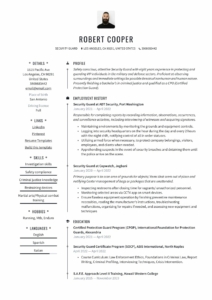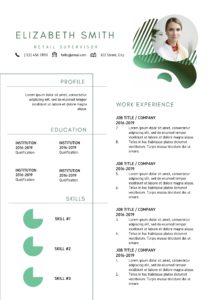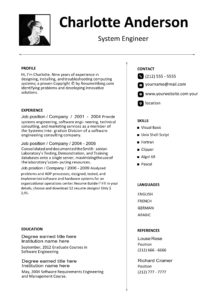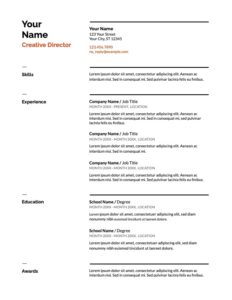Whether you’re a seasoned professional or fresh out of college and searching for your first job, your resume is one of the most crucial aspects of a comprehensive application.
However, building the perfect resume is one that also accurately reflects your experience regarding your educational history.
Read on for a quick guide on how to include education levels in your resume and what other information you should incorporate alongside it.
Decide Relevance
When crafting your resume, you should principally consider your educational history en masse and how it relates to the position. For example, you wouldn’t include college courses at the basic 101-level for a mid or upper-level job, but if you have a graduate degree, list relevant and impactful classes to boost credibility.
If the job you’re applying for has no relation to the degrees you have or course history, that’s okay! Read over the application requirements to ensure they don’t require a specific degree, and you should be fine listing your graduation dates and honors, awards, or thesis statements.
You can strategically order your educational information if your degree is irrelevant to the job you want. If you went to an Ivy League school with an excellent reputation, you may want to list that first. That way, employers know you took your education seriously, and while it may not be relevant to your position, it’s still impressive.
That said, the job you want may fall in line with your degree perfectly. In that case, examine your educational history (especially graduate or high-level undergraduate courses) and decide which ones hold the most relevancy. You don’t want to list every class you took in graduate school – just the ones that prove you’re the best candidate for the job.
Most Impressive First
Although you may want to save the best for last, listing your most impressive achievements at the top of your educational history is the preferred way to structure your list. Typically, they should be in reverse chronological order, but if you have multiple degrees at the same level, list them by relevance.
For example, if you’ve obtained a four-year bachelor’s degree as your highest level, you should list this first. If you received an associate’s degree on the way, list that next. Certificates, honors, and publications are also excellent to itemize in this segment of your resume.
Remember, the goal is to show employers that you’re the ideal candidate for the position. Including impressive information first ensures they review those achievements – so even if they skip the rest, they know you have credentials and educational experience.
Proper Order
Most employers prefer to see your job and career history before your educational details on your resume.
Of course, this can be an issue if you have not had a full-time job before the one you’re applying for, but any work-study positions or internships during college and graduate school can work for this, too. Your coursework, academic awards, and graduation details should be at the end of your resume.
If you’ve been in the workforce for a while, including your career history before your education solidifies your passion and dedication to the job. Employers want to see your past occupations and the experience you have under your belt before considering your degree(s).
After the education segment of your resume, include professional education certificate courses, conferences, publications, or other significant achievements.
Include Notable Accomplishments
There’s more to listing your education than just putting down your education level. You’ll want to include any notable accomplishments you’ve earned as well.
If you’ve ever presented for a conference during your career or held a webinar, include the title and date. Other options are projects you’ve managed, external educational opportunities you’ve explored, and completed professional education courses.
Nearly all graduate degrees require some form of thesis or dissertation. Include the title and publication date if you have one, and ensure you list the source for credibility.
Employers like to see that you’ve made an effort to expand your professional development and have the motivation to increase your knowledge base. Taking a few courses or attending conferences relevant to the position can also work under the educational history segment of your resume.
Additionally, if you have certificates in relevant subject matter, include those in your educational history, too. If you’re applying to be a project manager, a certificate in project management shows that you’ve taken steps to learn about the field.
What To Include
After you narrow down your choices for relevant coursework and achievements, it’s time to decipher what to include in your educational history segment. Overall, what you include will depend on your desired career. For example, if you’re applying for a trade, higher education other than trade school will likely be irrelevant.
In general, the most important aspects to include are:
- Your school and degree
- Graduation date
- Major/minor
- Degree(s) earned if you have multiple
You should also include the specific college or school within the university. So, list the name of the higher education institution and then the College of Business, College of Education, etc.
Unless the application specifies a GPA requirement, there’s no need to include it in your resume. Outlining your achievements and overall educational journey matters more to employers, especially those in the professional workforce. Remember, you want to keep things as brief as possible.

Signing Up
Figuring out how to list education on your resume can be challenging, but don’t let it worry you.
With some hard work, you can figure out the best way to list your education to catch the eyes of future employers. Make sure to stay succinct so that your employers want to continue reading your resume and see everything you have to offer.
From listing your impressive achievements first to professional development certificate courses, your motivation to keep moving forward and excel in your career should reflect in your resume.
For more tips on how to fill out your resume, be sure to browse the rest of our informative site.
How you list your education on your resume will depend on your present life circumstance. Each possible situation is shown in this guide.
1. As a HIGH SCHOOL STUDENT

Example:
If you are a high school student, education is most probably top of the list of what you have to showcase to your prospective employer. Therefore it should come at the top of your resume. Some high school students may possess work experience. This category is therefore divided into two sub-sections.
A) Without work experience
If you are in this category, the educational section of your resume should come after your contact address and introduction. Your resume as a high school student should contain the following
- CGPA (you may leave this out if it's below 3.0)
- The coursework you’ve taken that is relevant to the job you’re applying for.
- Academic awards or achievements thus far
- Clubs or organizations you have been actively involved with (it’s always best to avoid political, religious or controversial groups except if it's relevant to the prospective job)
A ‘Major achievements’ section may be added if you have activities that you feel is worth showcasing, but does not fall under clubs and organizations. The major accomplishments should advertise your desirable qualities such as leadership experience and organizational skills.
B) With work experience
If you are a high school student and you possess relevant work experience, your experience should still come after your education on a resume. If the work experience is significant enough, you may summarize your educational information in favor of a detailed description of your job experience. Asides that, your educational information listing should follow the outline stated above.
2. As a STUDENT/RECENT GRADUATE

A recent graduate as used in this context is anyone who graduated less than five years ago. For college students or recent graduates, a detailed educational background is still required since much of what you have to project as your career highlights would be educational achievements or results during the period of enrollment in the institution of study. Some people in this category may, however, have significant work experience so this class will be divided into two sub-sections.
a. Without work experience
If you fall into this category, your educational background should come at the beginning of your resume that is, after your contact information and introduction. A more detailed educational background is expected here. Clubs and organizations, relevant course works and information about your final year project as well as academic achievements should be provided if it is relevant to the job you’re applying for. A ‘major achievements’ section may also be added. The section would include information about educational competitions you have been involved in if any and information about your project work may be stated here if it is not relevant to the job in view. You should frame the information provided such that it depicts you as an active person with interpersonal, organizational and leadership skills.
b. With work experience
Pretty much the same rules stated above (for high school student with work experience) apply. Except that more details about your education would be expected since you are still an entry-level candidate. If your professional experience is significant enough, however, you should stifle the educational details in favor of work experience. Your GPA (if it’s more than 3.0), clubs and activities and educational achievement should be included.Remember work experience is more valuable out there than any educational achievement you might have. So if it’s not too late, you should start thinking of how you can gain relevant work experience in the industry you hope to build a career in, even while you’re still studying.
3. As a WORKING PROFESSIONAL

Example:
Listing education on a resume is pretty much straightforward for a working professional. Your work experience takes priority over your educational background so the educational information would succeed the professional information section in your resume. The purpose of schooling information here is just to state that you bagged an educational qualification of some sorts so bogus details may be skipped. Your GPA is not necessary at this level but if you graduated with any honors, be proud to state it. Your educational listing should simply include:
- Name of institution
- Location
- Field of study and qualification attained
- Year of graduation
- Honors (if any)
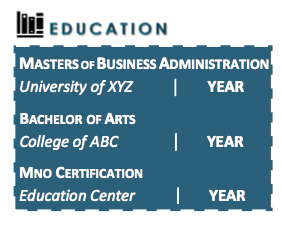
In case you’re pursuing a higher qualification than you currently possess which is essential to the job you’re applying for, your educational information may precede your professional experience. Your education will also come before experience in your resume if you’re an academic or scientific professional. Remember to state the qualification in view and the standard year of attainment.
